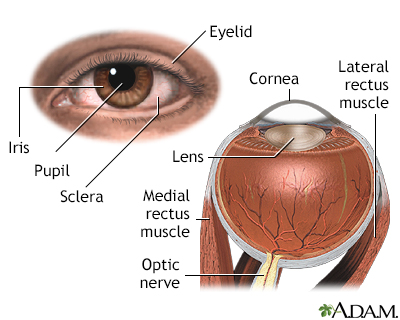Watery eyes
Watery eyes means you have too many tears in and draining from the eyes. Tears help keep the surface of the eye moist. They wash away particles and foreign objects in the eye.
Causes
Your eyes always contain tears made by the tear (lacrimal) glands just above the eyes. These tears leave the eye through a small hole in the corner of the eye called the tear duct (nasolacrimal duct).
Causes of watery eyes include:
- Allergy to mold, dander, dust
- Blepharitis (swelling along the edge of the eyelid)
Blepharitis
Blepharitis is manifest by inflamed, irritated, itchy, and reddened eyelids. It most often occurs where the eyelashes grow. Dandruff-like debris bu...
 ImageRead Article Now Book Mark Article
ImageRead Article Now Book Mark Article - Blockage of the tear duct
- Conjunctivitis
Conjunctivitis
The conjunctiva is a clear layer of tissue lining the eyelids and covering the white of the eye. Conjunctivitis occurs when the conjunctiva becomes ...
 ImageRead Article Now Book Mark Article
ImageRead Article Now Book Mark Article - Smog or chemicals in the air or wind
- Bright light
- Eyelid turning inward or outward
- Something in the eye (such as dust or sand)
- Scrape on the eye
- Infection
- Inward-growing eyelashes
- Irritation
Increased tearing sometimes happens with:
- Eyestrain
- Laughing
- Vomiting
Vomiting
Nausea is feeling an urge to vomit. It is often called "being sick to your stomach. "Vomiting or throwing-up forces the contents of the stomach up t...
 ImageRead Article Now Book Mark Article
ImageRead Article Now Book Mark Article - Yawning
Yawning
Yawning is involuntarily opening the mouth and taking a long, deep breath of air. This is most often done when you are tired or sleepy. Excessive y...
Read Article Now Book Mark Article
One of the most common causes of excess tearing is dry eyes. Drying causes the eyes to become uncomfortable, which stimulates the body to produce too many tears. One of the main tests for diagnosing excess tearing is to check whether the eyes are too dry.
Dry eyes
You need tears to moisten your eyes and to wash away particles that have gotten into your eyes. A healthy tear film on the eye is necessary for good...

Home Care
Treatment depends on the cause of the problem. Therefore, it is important to determine the cause before treating yourself at home.
When to Contact a Medical Professional
Tearing is rarely an emergency. You should seek help right away if:
- Chemicals get into the eye
- You have severe pain, bleeding, or loss of vision
- You have a severe injury to the eye
Also, contact your health care provider if you have:
- A scratch on the eye
- Something in the eye
- Painful, red eyes
- A lot of discharge coming from the eye
- Long-term, unexplained tearing
- Tenderness around the nose or sinuses
What to Expect at Your Office Visit
Your provider will examine your eyes and ask questions about your medical history and symptoms. Questions may include:
- When did the tearing start?
- How often does it happen?
- Does it affect both eyes?
- Do you have vision problems?
- Do you wear contacts or glasses?
- Does the tearing happen after an emotional or stressful event?
- Do you have eye pain or other symptoms, including headache, stuffy or runny nose, or joint or muscle aches?
- What medicines do you take?
- Do you have allergies?
- Did you recently hurt your eye?
- What seems to help stop the tearing?
Your provider may order tests to help determine the cause.
Treatment depends on the cause of the problem.
Reviewed By
Neil K. Kaneshiro, MD, MHA, Clinical Professor of Pediatrics, University of Washington School of Medicine, Seattle, WA. Also reviewed by David C. Dugdale, MD, Medical Director, Brenda Conaway, Editorial Director, and the A.D.A.M. Editorial team.
Borooah S, Tint NL. The visual system. In: Dover AR, Innes JA, Fairhurst K, eds. Macleod's Clinical Examination. 15th ed. Philadelphia, PA: Elsevier; 2024:chap 8.
Olitsky SE, Marsh JD. Disorders of the lacrimal system. In: Kliegman RM, St. Geme JW, Blum NJ, Shah SS, Tasker RC, Wilson KM, eds. Nelson Textbook of Pediatrics. 21st ed. Philadelphia, PA: Elsevier; 2020:chap 643.
Örge FH. Examination and common problems in the neonatal eye. In: Martin RJ, Fanaroff AA, Walsh MC, eds. Fanaroff and Martin's Neonatal-Perinatal Medicine. 11th ed. Philadelphia, PA: Elsevier; 2020:chap 95.
Seller RH, Symons AB. Vision problems and other common eye problems. In: Seller RH, Symons AB, eds. Differential Diagnosis of Common Complaints. 7th ed. Philadelphia, PA: Elsevier; 2018:chap 34.

 All rights reserved.
All rights reserved.